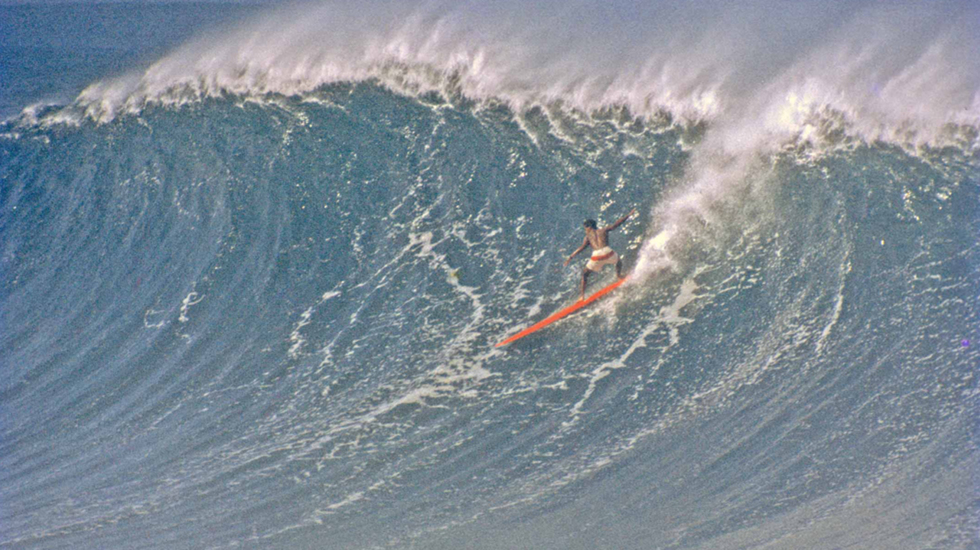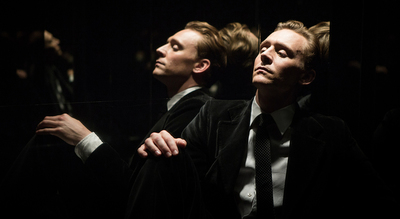
BY KAREN KEMMERLE |
30 for 30 Filmmaker Sam George on The 'Hawaiian' and the Perils of Directing Re-enactments
'Hawaiian: The Legend of Eddie Aikau' celebrated its world premiere at TFF 2013. Watch it again this Tuesday, Oct 1, at 8PM ET on ESPN.

ESPN’s much-lauded 30 for 30 documentary series kicks off again October 1st with the fascinating Hawaiian: The Legend of Eddie Aikau, narrated by actor and surf enthusiast Josh Brolin. Sam George’s documentary on one of the most well-known Hawaiian big wave rider takes audiences behind the myth to show exact what kind of man Aikau was. Despite the fame that surfing brought him, Aikau remained devoted to his family, cultural traditions, and his job as a lifeguard on Waimea Bay.
Since its world premiere at the 2013 Tribeca Film Festival, Hawaiian: The Legend of Eddie Aikau has went on to play at numerous festivals including the Maui Film Festival. We got the opportunity to speak to director Sam George about the importance of surfing in Hawaiian culture, his decade-spanning collaboration with Stacy Peralta, and why you should never shy away from eye contact.
Tribeca: What first drew you to the story of Eddie Aikau? Did growing up in Hawaii make you feel a certain kinship with Aikau?
Sam George: In March of 1978, my brother and I had returned to Hawaii with my father, who was fleeing a cold spring in his native Ohio. On the afternoon of the 16th we were surfing in Waikiki when we saw the Hokule’a pass by, surrounded by a small fleet of press boats and well-wishers. Having read that Eddie Aikau was among the crew, my brother and I waved, giving him a surfer’s send-off.
It wasn’t until two days later that we heard he’d been lost. It may well be that I was one of the last surfers to see Eddie Aikau alive. 33 years later, when the opportunity to tell his remarkable story presented itself, I jumped at it.
Tribeca: Oscar-nominee Josh Brolin narrates the film. How did Brolin come to the project? Is he a surfing fan?
SG: Josh Brolin is not only a surfing fan, but an accomplished surfer. I’d first met Josh in the early 1980s, when his dad brought him into the surf shop where I worked to get a new wetsuit. He was already a hot little surfer by then, so we sponsored him, providing free suits. Fast forward to earlier this year, I ran into Josh out in the surf near Malibu. We chatted, reminisced, and it occurred to me that Josh would make the ideal narrator for our film. We asked, and he enthusiastically said yes.
Eddie stood up for people he didn’t necessarily even like, all out of an inherent sense of fairness.
Tribeca: From conception to print, how long did it take to make Hawaiian: The Legend of Eddie Aikau?
SG: The entire process took almost two and a half years, from the moment Stacy Peralta asked, “Do you think there’s a good movie in the story of Eddie Aikau?” and I said “No, I think there’s a great movie in the story of Eddie Aikau,” to the October 1st premiere on ESPN.
Tribeca: I was struck by the mix of archival and recreated footage that you used in Hawaiian: The Legend of Eddie Aikau. Can you discuss the challenges of using reenactments? Why did you make did you make the choice to blend the two?
SG: A number of the most dramatic episodes in Eddie’s life were never documented, and so I felt that re-enactments were going to be essential in bringing his character to life. Eddie died at age 32, still a young man. But so many of his family and friends are still here to tell his story. If the film was going to be something more than just people talking about Eddie, I needed him to become an actual character in the story, an actual living, moving, physical character.
We actually shot many more re-enactments than we eventually used. But in a series of test screenings we discovered that the more Eddie we showed, the less real he seemed. So it was a real balancing act, depicting him on screen while maintaining the necessary suspension of disbelief. And I think we succeeded: I had a number of people ask me “Where did you find that footage of Eddie paddling away from the Hokule’a?”
 Tribeca: You have co-written documentaries with Stacy Peralta (Riding Giants and Crips and Bloods: Made in America) and directed another yourself (Hollywood Don’t Surf), but this was a different type of beast. Were you at all daunted by the task? Did Peralta offer you any advice?
Tribeca: You have co-written documentaries with Stacy Peralta (Riding Giants and Crips and Bloods: Made in America) and directed another yourself (Hollywood Don’t Surf), but this was a different type of beast. Were you at all daunted by the task? Did Peralta offer you any advice?
SG: Hawaiian was the first time I’d be directing actors and crew in the re-enactments. Stacy, who has known me since I was 19 years old, anticipated my trepidation. “Sam, the first time you say ‘Action’ you’re going to feel like an imposter,” he said. “But remember, all you’re doing is telling a story. The cast and crew are your keyboard. Oh, that and do whatever your DP says.” Very helpful advice, as it turned out.
Tribeca: Eddie Aikau was so much more than a great big-wave rider. He constantly risked his life for others during his days as a lifeguard at Waimea Bay and was devoted to his family. Is it his generosity that makes him such a compelling subject? What was the most surprising thing you learned about him?
SG: The most surprising thing to learn was the ways in which Eddie Aikau was a hero in the most authentic sense of the word. Big wave riders do it for fun—dramatic, dynamic fun, but fun nonetheless. Eddie put himself in harm’s way for the sake of others. He cared about others, from his first day on the job as a lifeguard at Waimea Bay to his very last moment, paddling to get help in an attempt to save his stricken crewmates. Eddie stood up for people he didn’t necessarily even like, all out of an inherent sense of fairness. It was a wonderful thing to discover that the legend was a true hero.
Tribeca: His family—Sol, Myra, Clyde and his ex-wife Linda—spoke so lovingly about Eddie. Were they all eager to participate in the film or did they need any convincing?
SG: Before we could even begin work on the film, producer Paul Taublieb and I traveled to the Big island of Hawaii to talk with Solomon Aikau. We met at the Pine Trees Café, a Hawaiian ‘plate lunch’ diner outside of Kona. Sol sat across from us while I gave him our pitch. He looked up from his ‘teri-beef with two scoop rice and macaroni salad’ and said, “That’s all fine. But I just wanted to look into your eyes and see what sort of men you were.” He must have seen something he liked because he gave the family’s blessing right then and there. We were really under pressure, knowing that if we didn’t get this story right, we could never go back to Hawaii again.
A number of the most dramatic episodes in Eddie’s life were never documented, and so I felt that re-enactments were going to be essential in bringing his character to life.
Tribeca: It was really difficult to watch Nainoa Thompson and others recount Eddie’s final moments before he paddled away to try and get help for the capsized Hokule’a crew. As an interviewer, how did you make your subjects feel comfortable enough to share their experiences?
SG: The hardest thing—and again this is something I learned from Stacy Peralta—is to keep your mouth shut. It’s tough to sit there, making direct eye contact with somebody who’s experiencing a wrenching, emotional moment, and not try to comfort them. And yet it’s the eye contact that makes the difference. I’m not a reporter conducting an interview, not looking back and forth at my notes, asking questions.
I’m sitting at their feet, looking directly up at them, engaged in their story. They have to see it in my eyes, that I’m right there with them, that it’s just them and me. That they’re safe. That’s not easy in a studio filled with strangers pointing lights and cameras and microphones at them. You can’t do it with words. It’s all in the eyes.
Tribeca: How important a role does surfing play in preserving Hawaiian culture in the face of Westernization and globalization?
SG: Think about this: the grass skirt is from Micronesia, the ukulele is from Portugal and the pineapple is from the Philippines. Of all the iconic images associated with Hawaii, only surfing is indigenous. A wonderfully articulate history professor named Dr. Isaiah Helekunihi Walker puts it best when he states, quite simply, that in the face of centuries of cultural marginalization, the surf zone is one of the last places where you can actually be Hawaiian. That’s a cultural significance unique in all of sport.
Hawaiian: The Legend of Eddie Aikau airs on ESPN this Tuesday at 8PM ET.

